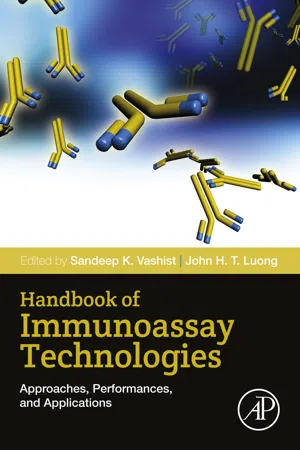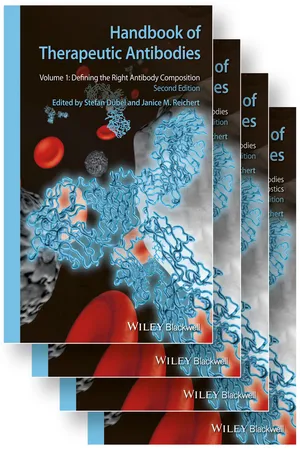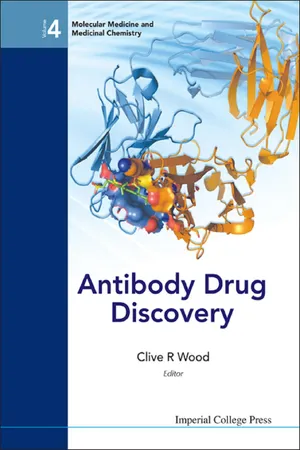Biological Sciences
Phage Display
Phage display is a laboratory technique used to study protein-protein interactions and identify specific peptide sequences that bind to a target molecule. It involves genetically engineering bacteriophages to display foreign peptides on their surface, allowing researchers to screen and select for peptides with desired binding properties. This method has applications in drug discovery, vaccine development, and understanding protein function.
Written by Perlego with AI-assistance
Related key terms
Related key terms
1 of 4
Related key terms
1 of 3
10 Key excerpts on "Phage Display"
- eBook - ePub
- Boriana Marintcheva(Author)
- 2017(Publication Date)
- Academic Press(Publisher)
Chapter 5 Phage Display Abstract Phage Display is a powerful technique for studying protein–ligand interactions most frequently applied to protein–protein, protein–peptide, and protein–nucleic acids interactions. The genetic code for the protein/peptide of interest is inserted in the genome of a phage and subsequently “displayed” on the surface of the viral particle as a fusion to natural coat protein. Libraries of protein/peptide variants are tested against ligand(s) of interest. Proteins/peptides binding to the specific target are selected by 3–5 rounds of affinity-driven biopanning and subsequently identified by sequencing the genome of the phages displaying them. Phage Display is widely used for a selection of proteins/peptides with desired binding properties for the purpose of a broad array of therapeutic, research, and nanotechnology-related applications. Keywords Biopanning; Peptide library; Phage Display; Phage-assisted continuous evolution Phage Display is a well-established technique for identification, selection, and evolution of protein–ligand interactions widely used to address basic science questions, as well as to develop top-notch technology in diverse fields ranging from research tools to personalized medicine and nanotechnology. Phage Display has more than 30 years long history that has reaffirmed the power of the approach and resulted in the development of multiple display techniques to meet the continuous challenge of studying the vast diversity of protein–ligand interactions taking place in living matter. The first reports describing Phage Display were published in the 1980s and ever since the technique has been continuously improving as advances in molecular biology and various technologies are being used to build on its simple but brilliant principles. Today scientists have in their disposal multiple in vivo and in vitro display techniques allowing sophisticated studies and manipulations of a broad range of protein–ligand interactions - eBook - ePub
- Sheldon J. Park, Jennifer R. Cochran(Authors)
- 2009(Publication Date)
- CRC Press(Publisher)
1 Phage Display Systems for Protein EngineeringAndreas Ernst and Sachdev S. SidhuCONTENTS- The Phage Display Concept
- Phage Structure and Assembly
- Vectors and Platforms
- The Selection Process
- Evolution of Binding Agents
- Improvement of Protein Stability and Folding
- Identifying Natural Protein–protein Interactions
- Specificity Profiling of Peptide-Binding Modules .
- Mapping Binding Energetics
- Future Perspectives
- References
Information in biological systems is contained and passed on through genes, while the traits of a biological system are given by the functions of encoded proteins and other macromolecules. In molecular biology, the focus of research is the function of biological macromolecules, especially proteins, which are studied in an isolated setting, allowing us to develop our understanding of biological systems. However, these studies are usually limited to a small set of states that can be established in the experiment. With Phage Display, we can study proteins and protein–protein interactions on a combinatorial scale. This means that it is possible to probe billions of different protein variants simultaneously. Phage Display can be applied to the generation of affinity reagents, which are invaluable tools for diagnostics and therapeutic development. The technology can also be used for improving protein stability and for identifying and mapping natural protein–protein interactions in detail.THE Phage Display CONCEPT
Phage Display technology provides an in vitro version of classical Darwinian evolution by establishing a physical linkage between a polypeptide and the encoding genetic information. By mutating DNA encoding for a displayed polypeptide, it is possible to generate a multitude of related variants. This library of variants can be displayed on the surfaces of phage particles, while the DNA encoding for each variant is encased in the phage capsid (Figure 1.1 - eBook - ePub
Phage Display of Peptides and Proteins
A Laboratory Manual
- Brian K. Kay, Jill Winter, John McCafferty(Authors)
- 1996(Publication Date)
- Academic Press(Publisher)
CHAPTER 2Principles and Applications of Phage Display
Brian K. Kay and Ronald H. HoessINTRODUCTION
The display of peptides and proteins on the surface of bacteriophage represents a powerful new methodology for carrying out molecular evolution in the laboratory. The ability to construct libraries of enormous molecular diversity and to select for molecules with predetermined properties has made this technology applicable to a wide range of problems. The origins of Phage Display date to the mid-1980s when George Smith, on sabbatical in Bob Webster’s laboratory at Duke University, first expressed a foreign segment of a protein on the surface of bacteriophage M13 virus particles. As a test case he fused a portion of the gene encoding the Eco RI endonuclease to the minor capsid protein pIII (Smith, 1985 ). Using a polyclonal antibody specific for the endonuclease, Smith demonstrated that phage containing the Eco RI–gIII fusion could be enriched more than 1000-fold from a mixture containing wild-type (nonbinding) phage with an immobilized polyclonal antibody. From these first experiments emerged two important concepts. First, using recombinant DNA technology, it should be possible to build large libraries (i.e., 108 ) wherein each Phage Displays a unique random peptide. Second, the methodology provides a direct physical link between phenotype and genotype. That is, every displayed molecule has an addressable tag via the DNA encoding that molecule. Because of the ease and rapidity of DNA sequence analysis, selected molecules can be identified quickly. It is interesting to note that the idea of addressable tags is also now being adopted in some combinatorial chemical libraries (Needels et al ., 1993;Ohlmeyer et al ., 1993). Within a few years of George Smith’s experiments the first phage-displayed random peptide libraries were assembled (Cwirla et al ., 1990;Devlin et al ., 1990; Scott and Smith, 1990 ), accompanied by reports that properly folded and functional proteins could also be displayed on the surface of M13 (Bass et al ., 1990;McCafferty et al - eBook - ePub
Handbook of Immunoassay Technologies
Approaches, Performances, and Applications
- Sandeep K. Vashist, John H.T. Luong, Sandeep K. Vashist, John H.T. Luong(Authors)
- 2018(Publication Date)
- Academic Press(Publisher)
[3] .Research antibodies are used in standard methods such as enzyme-linked immunosorbent assays (ELISAs), Western blotting, immunohistochemistry (IHC), flow cytometry, or affinity chromatography. Furthermore, antibodies are important tools to decode the human proteome [4] or to measure clinical parameters such as pharmacokinetics during drug development [5 ,6 ].For most of these applications, the use of recombinant antibodies is highly advantageous or even necessary. Several in vitro technologies have been developed to generate such recombinant antibodies. Of these, Phage Display is the most widely used method. It is based on the presentation of antibody fragments on the surface of phages that contain the corresponding DNA. The phage thus directly links phenotype and genotype of the antibody, enabling selection in vitro .1.1. History of the Development of Antibody Phage Display
Phage Display was invented in 1985 when George Smith demonstrated that an exogenous protein could be expressed on the surface of the filamentous phage M13 [7] . Smith inserted the DNA coding for a fragment of the EcoRI endonuclease into the phage gene III, which codes for a protein at the tip of the phage, the minor capsid protein III. He was able to detect the EcoRI-pIII fusion protein on the surface of phages with polyclonal antibodies targeting the EcoRI endonuclease. Additionally, he showed that phages bearing the fusion protein on their surface could be selected from a mixture containing a large excess of wild-type phages. In 1989, Richard Lerner and colleagues were able to isolate antibody fragments from a library of randomly combined murine variable heavy and variable light chains through Phage Display [8] , thereby presenting an alternative to hybridoma technology for the generation of monoclonal antibodies. One year later, McCafferty et al . expressed a single-chain variable fragment against lysozyme on the surface of bacteriophages and showed specific binding of this phage antibody in an ELISA [9] . Furthermore, the phage antibody was purified from a mixture of wild-type phages using a column of lysozyme-sepharose. The first human Phage Display antibody libraries were created in the early 1990s [10 ,11 ]. Currently, Phage Display has proven to be the most widely used in vitro antibody selection technology [1] - eBook - ePub
Therapeutic Monoclonal Antibodies
From Bench to Clinic
- Zhiqiang An(Author)
- 2011(Publication Date)
- Wiley(Publisher)
E. coli did not remove the major barrier for the broad application of antibodies in therapy as repeated administration of mouse-derived antibodies causes a human anti-mouse antibody (HAMA) response (Courtenay-Luck et al. 1986). This problem can be overcome by two approaches: humanization of mouse antibodies (Studnicka et al. 1994) or employing repertoires of human antibody genes. The second approach was achieved in two ways. First, human antibody gene repertoires were inserted into the genomes of IgG-knockout animals, allowing the generation of hybridoma cell lines that produce human immunoglobulins (Jakobovits 1995; Lonberg und Huszar 1995; Fishwild et al. 1996). However, this method still requires immunization and has limitations in respect of toxic and conserved antigens.These restrictions do not apply for the second approach: the complete in vitro generation of specific antibodies from human antibody gene repertoires. There, despite the constant suggestion of novel methods like bacterial surface display (Fuchs et al. 1991; for review see Jostock and Dübel 2005), ribosomal display (Hanes and Plückthun 1997; He and Taussig 1997), puromycin display (Roberts and Szostak 1997), covalent display (Reiersen et al. 2005), CIS-display (Odegrip et al. 2004) or yeast surface display (Boder and Wittrup et al. 1997) (for comparision see Table 8.1 ), Phage Display has become the most widely used and most robust selection method. It is based on the groundbreaking work of Smith (1985).8.2 HOW Phage Display WORKSThe currently dominating antibody Phage Display systems are based on the groundbreaking work of Smith (1985) on peptide display on the surface of filamentous phage. Historically, the first antibody gene repertoires in phage were generated and screened by using the lytic phage Lambda (Huse et al. 1989; Persson, Caothien, and Burton 1991), but with quite limited success. This changed when antibody fragments were presented on the surface of filametous phage of the M13 /fd family, fused to pIII (McCafferty et al. 1990; Barbas et al. 1991; Breitling et al. 1991; Clackson et al. 1991; Hogenboom et al. 1991; Marks et al. 1991). Here, genotype and phenotype of an antibody fragment were linked by fusing its encoding gene fragment to the minor coat protein III gene of the filamentous bacteriophage M13. This resulted in the expression of a fusion protein on the surface of phage, allowing affinity purification of the antibody gene by antibody fragment binding to its antigen (Fig. 8.1 ). By uncoupling antibody gene replication and expression from the phage life cycle by locating them on a separate plasmid (phagemid)—containing a phage packaging sequence—genetic stability, propagation, and screening of antibody libraries was greatly facilitated (Barbas et al. 1991; Breitling étal. 1991; Hoogenboom et al. 1991; Marks et al. 1991). To date, single-pot (see below) antibody libraries with a theoretical diversity of up to 1011 - eBook - ePub
- James E. Crowe, Diana Boraschi, Rino Rappuoli(Authors)
- 2015(Publication Date)
- ASM Press(Publisher)
ANTIBODY DISCOVERY APPROACHES
Passage contains an image
Phage and Yeast Display 6
JARED SHEEHAN1 and WAYNE A. MARASCO11 Department of Cancer Immunology and AIDS, Dana-Farber Cancer Institute, Harvard Medical School, Boston, MA 02215DISCOVERY OF THERAPEUTIC ANTIBODIES USING Phage Display TECHNOLOGY
Bacteriophage Biology and Antibody Display Method
Bacteriophage (phage) are viruses that infect and replicate within bacterial cells. Filamentous phage particles inject single-stranded DNA into target bacterial cells for subsequent replication and assembly of new virions within the host cytoplasm. The filamentous phage species capable of infecting Escherichia coli manifest as long, thin filaments that are secreted from host bacteria without cell lysis. Due to their ease of manipulation and stability in a range of temperatures and pH, F pilus-specific filamentous phage species, including f1, fd, and M13, serve as reliable vehicles for combinatorial technologies, such as Phage Display (1 –4 ).A collection of the first human antibody libraries displayed on the phage surface was published in the early 1990s (5 –8 ). This antibody Phage Display technology is based upon a large collection of human antibody genes subcloned into an E. coli expression vector, which is packaged into filamentous phage. Upon production from host bacterial cells, these phage particles display the antibody fragment on its surface as a fusion product with one of the viral coat proteins. This established library must be screened to isolate the phage antibodies of interest. To ensure representation of all immunoglobulin variants within the library, a larger number of phage particles—above the total number of unique antibody sequences—is typically screened. This fold-excess in selection experiments is easily achieved since filamentous phage can produce titers up to 1013 particles per ml of culture (1 ).The purpose of antibody display library selections is to isolate an antibody variant with the desired functional properties. A purified, heterogeneous population of phage library members is screened to identify and enrich for the antibody sequences of interest. This phage library selection typically involves the capture of the target antigen, either by immobilization on a plastic surface (solid phase) or coupled to magnetic beads (solution phase). When incubated with this captured antigen, the phage surfaces—purified virions in solution—allow binding of specific antibody variants. Multiple washes remove nonbinding phage particles, while attached phage are typically eluted under either low- or high-pH conditions to disrupt the antibody-antigen association. Following this elution step, these phage antibodies are used to infect an E. coli culture for amplification of the antigen-reactive library subpopulation. The purified, amplified phage antibodies from this initial selection event are used for subsequent rounds of panning. Due to the possibility of nonspecific binding, at least two to three rounds of this type of iterative library selection are performed to enrich for positive binders and reduce “background” binding events. An overview of this phage library selection procedure is outlined in Fig. 1 - eBook - ePub
- Stefan Dübel, Janice M. Reichert, Stefan D¿bel, Janice M. Reichert(Authors)
- 2014(Publication Date)
- Wiley-Blackwell(Publisher)
For this purpose, a panel of technologies were developed such as bacterial surface display [21–23], yeast surface display [24–26], ribosomal display [27–30], or puromycin display [31] (Table 3.1). Despite these manifold technologies, Phage Display became the most widely used selection method. Table 3.1 Comparison of recombinant antibody selection systems Selection system Advantages Disadvantages Transgenic mice Hybridoma technology Somatic hypermutation Immunization required, not freely available Cellular display Bacteria N- and C-terminal and sandwich fusion Not matured, requires individual sorting Yeast Display of larger proteins, N- and C-terminal and sandwich fusion Requires individual sorting Intracelluar display Yeast two hybrid Screening library versus library possible Cytoplasm not optimal for antibody folding Molecular display Puromycin/ribosomal Largest achievable library size in vitro Finicky method Phage Display Filamentous Genomic Robust, multivalent display Prone to mutation, phage production and propagation are coupled, only C-terminal fusion Phagemid Robust, monovalent, and multivalent display by choice of helperphage Only C-terminal fusion T7 Well suited for peptide display No display of antibody fragments, lytic phage Arrays Gridded. clones Robust, simple Small library sizes Modified from Ref. [32]. 3.2 Phage Display An alternative for the generation of human antibodies is antibody Phage Display, which is completely independent of any immune system by utilizing an in vitro selection process. Display systems employing insertion of antibody genes into the phage genome have been developed for phage T7 [33] and phage Lambda [34–36]. However, these systems were not really suitable for antibody generation. The most commonly used display method was developed by George P. Smith [37] on filamentous phage (f1, fd, M13) - eBook - ePub
- Clive R Wood(Author)
- 2011(Publication Date)
- ICP(Publisher)
et al., 2009).2.4.3 Advantages and successes of Phage DisplayPhage Display of antibody fragments has developed in multiple directions and techniques since the earliest breakthroughs in 1990. During that time clear advantages over classical hybridoma technologies in certain instances have been demonstrated. For example, Phage Display allows for the rapid isolation of antibodies to any conceivable antigen, including toxins and antigens that have very high degrees of sequence homology across mammalian species and are difficult to obtain via conventional immunization of rodents. From large naive antibody libraries, diverse panels of specific antibodies can be generated to a plethora of different epitopes on a single protein. In combination with high-throughput methodologies for selection, screening and analysis, it is now possible to produce specific antibodies on a proteomic scale. Moreover, the concept of designer antibodies with exquisite specificity, functionality and picomolar affinities is now a reality with more and more of these types of antibodies entering the clinic for therapeutic intervention of a multitude of diseases. Such successes are exemplified below.2.4.3.1 Species cross-reactivityHistorically, species cross-reactivity has been assessed post-isolation of an antibody using the classical hybridoma approach. However, antibody Phage Display allows the scientist to drive the panning selection towards isolating binders which are specifically cross-reactive with protein orthologs from other animal species. This can be particularly useful in the design of antibody therapeutics where the toxicological effect of treatment with a given antibody specificity can be assessed in rodents or primates, prior to administration in humans. Such species cross-reactivity is typically achieved by performing selections on a combination of human, mouse and primate orthologs either separately or in succession, and subsequently screening for the appropriate cross-species reactivity profile. Examples of selections for cross- species reactivity include: human and rodent Nogo-66 (Hofer et al., 2007), human and murine BR3 (Lee et al., 2006), human and murine VEGF (Liang et al., 2006), human and murine VEGF receptor (Popkov et al., 2004), and human and rhesus monkey Lymphocyte Function-Associated Antigen 1 (Werther et al., - eBook - ePub
- Stefan Lutz, Uwe Theo Bornscheuer(Authors)
- 2012(Publication Date)
- Wiley-VCH(Publisher)
Phages are ‘sticky’ towards themselves and towards solid supports and, when concentrated, can form soluble aggregates that will dissociate relatively slowly. Therefore it is recommended that all phage solutions be vortexed thoroughly before infection. As the phage will also stick to micropipette tips, the tips should be changed when performing serial dilutions. Finally, when the phages are highly diluted, a time-dependent loss of infection may result from their binding to the vessel walls. Hence, it is recommended either that silanized microtubes are used, that 1% BSA is added to the solution, or that highly diluted solutions should not be kept for long periods of time.24.3.12.2 Displayed Protein is Degrading with Time
This effect may be due to the presence of proteases or to an inherently low protein stability. A ‘cocktail’ of protease inhibitors can be added (Complete tabs, Roche), and freshly prepared phage solutions should always be added when performing selection from libraries.24.3.12.3 Phages are not Genetically Stable
This may be due to a low toxicity of the fusion protein or to recombination with homologous E. coli genes. The solution is to use a recA strain such as JM109 to reduce recombination. To avoid problems of toxicity, a phagemid vector such as pHDi.Ex [92] should be used, as this allows control of the fusion protein expression. With this vector, a strong repression will be obtained by adding 1% glucose (catabolic repression).24.3.12.4 The Ratio ‘Out/In’ is not Increasing with the Selection Rounds
This may mean that no clones are being selected. For some strategies where low-affinity capture may be necessary for selection, the level of specifically captured phages may always be below the background level. It is therefore worth analyzing the selected phages as an effective enrichment may have occurred.24.4 Conclusions and Future Challenges
In less than 25 years, Phage Display has become a robust and extremely powerful technology for creating artificial protein binders that could find applications both in fundamental research and industrial processes. The first therapeutic antibodies evolved by Phage Display are now available commercially, more are in clinical trials and, most certainly, many more will follow. There is no doubt that the use of antibodies will continue to increase in the near future, although alternative scaffolds are emerging with attractive advantages such as small size, a high level of recombinant expression or intracellular applicability. Now, with a good scaffold and a good library, the selection of strong binders is not exceptional, perhaps even easy, and alternatives to antibodies are changing their status from small outsiders to serious competitors. Even more promising, the engineering of bifunctional proteins that combine a binding site with a fluorescent property, an enzymatic active site or another binding site is probably the next major challenge. These proteins would be capable of both recognizing a target and transmitting a signal, and should find useful applications in diagnostics or immunotherapies. - eBook - ePub
- Tasuku Honjo, Michael Reth, Andreas Radbruch, Frederick Alt, Michael Neuberger(Authors)
- 2004(Publication Date)
- Academic Press(Publisher)
152 ]. This approach can thus be employed to select for “neoepitopes,” which are formed upon protein activation.Selections can be performed on more complex mixtures of antigen, including intact cells, as long as measures are taken to prevent the enrichment of phage antibodies that bind to nonrelevant cell-surface antigens. Cell-surface antigen-specific antibodies have been isolated by selecting phage antibody libraries on adult erythrocytes [114 ], fetal erythrocytes [90 ], lymphocytes [116 ], melanoma cells [106, 107 ], and breast tumor cells [36 ]. For highly expressed antigens, specific antibodies may be isolated by direct selection on cells [114 ]. For antigens expressed at lower density, it is frequently necessary to deplete the library of binders to other antigens using a closely related cell type [36, 114 ]. Multivalent phage antibody libraries may be more useful for cell selections, due to the more efficient selection resulting from avidity [89, 90 ]. It has also proved possible to directly select phage antibodies that trigger receptor-mediated endocytosis [36 ], since phage antibodies binding internalizing cell surface receptors can undergo receptor-mediated endocytosis [34 ]. Such antibodies may prove particularly useful for the intracellular delivery of therapeutic molecules [153, 154 ]. Bacterial or mammalian cells can also be used as “living columns” for antibody selection, by either fusing the antigen gene to a cell-surface protein gene [155 ], or by transfecting the cell with the gene for a cell-surface antigen [156 ].INCREASING ANTIBODY AFFINITY USING Phage Display
Phage Display is a powerful tool for increasing antibody affinity to values not achievable using hybridoma technology [1, 3 ]. To increase affinity, the antibody sequence is diversified, a phage antibody library is constructed, and higher affinity binders are selected on antigen [31, 157 –159
Index pages curate the most relevant extracts from our library of academic textbooks. They’ve been created using an in-house natural language model (NLM), each adding context and meaning to key research topics.
Explore more topic indexes
Explore more topic indexes
1 of 6
Explore more topic indexes
1 of 4









